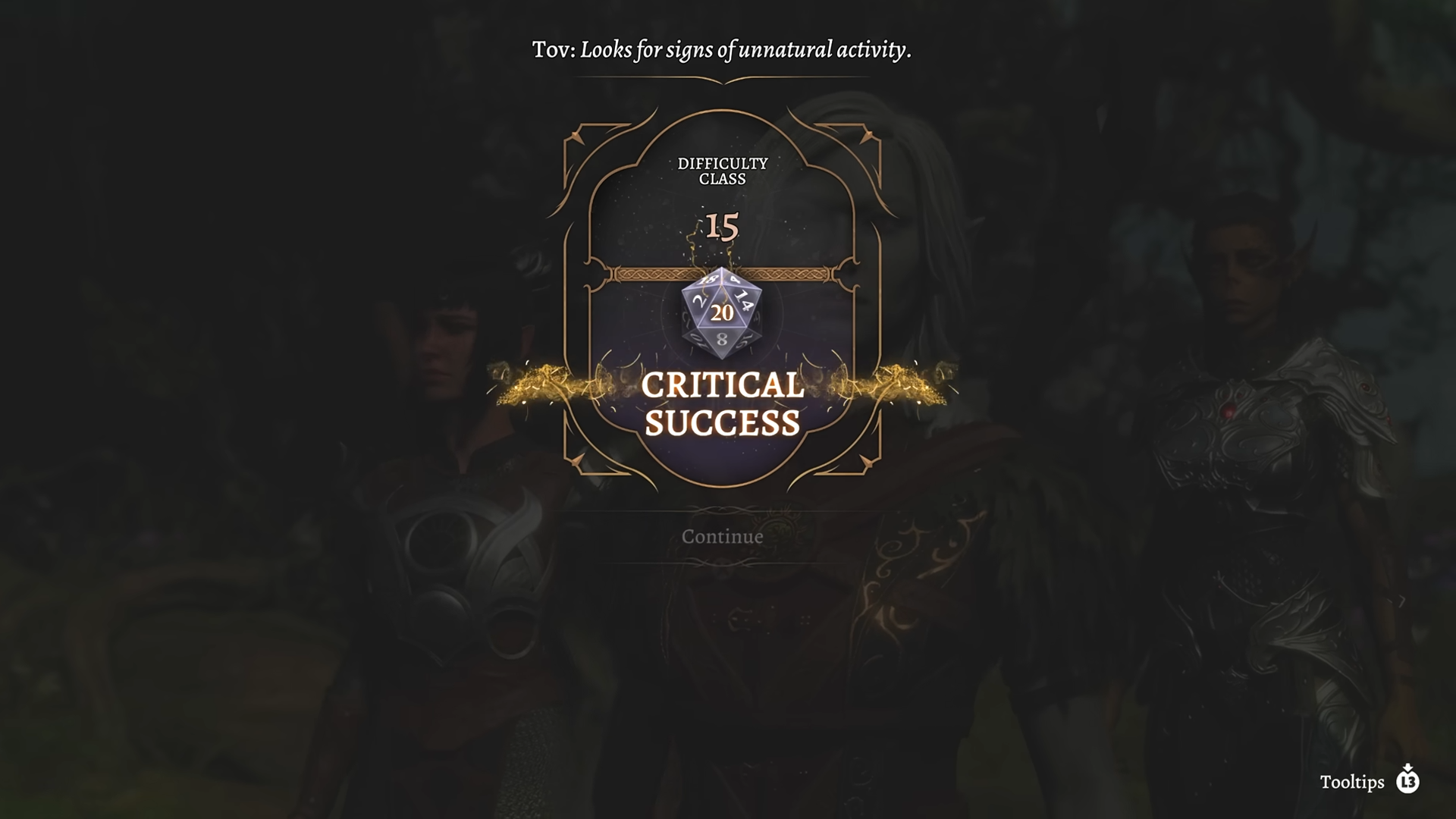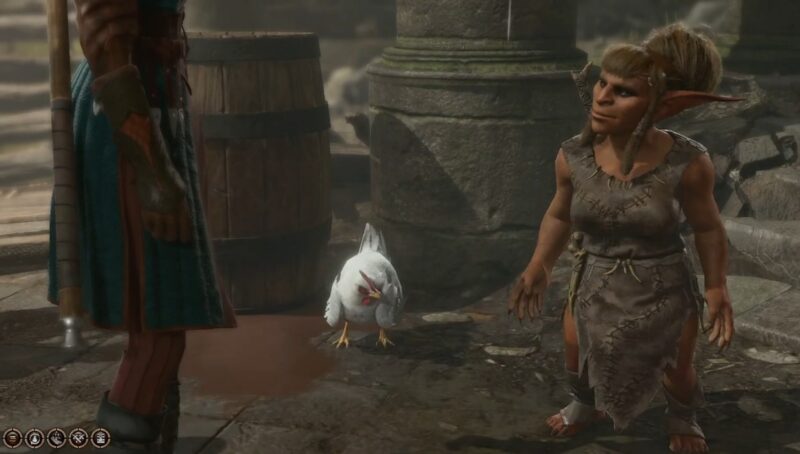Combat is a fundamental aspect of combat in Baldur’s Gate 3, and in this guide, we will explain the mechanics, resources, and philosophy behind combat in BG3.
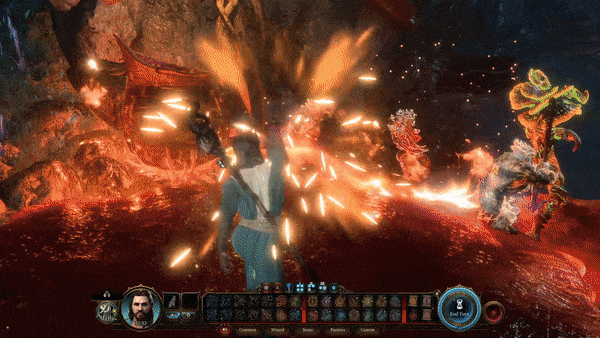
How Does Combat Work in Baldur’s Gate 3?
Baldur’s Gate 3 is a role-playing video game developed by Larian Studios, based on the Dungeons & Dragons 5th Edition rules. Combat in Baldur’s Gate 3 follows the classic turn-based system found in many tabletop RPGs, which allows players to control their characters’ actions during combat.
Each Class, Race, and Origin Character brings distinct skills, abilities, strengths, and weaknesses, providing players with diverse gameplay experiences. Players explore the environment in real-time and when combat initiates, the game seamlessly transitions into turn-based combat mode, granting players, companions, and enemies their respective turns. In this Combat Explained guide, we will delve deep into the game’s combat mechanics, equipping you to face the challenges of Baldur’s Gate 3 with confidence.
Here’s a guide on how combat works in Baldur’s Gate 3:
- Turn-Based System: Each combat round is divided into turns where individual characters can take turns using action resources.
- Action Points: Characters have a limited number of action points during their turn and use the to cast spells, abilities, items, or movement.
- Initiative: Combat begins with an initiative roll, which determines the order in which characters and enemies take their turns.
- Movement: Characters can move a certain distance during their turn, depending on their movement speed.
- Attacking: select the target and the attack action then the game will calculate the chance to hit based on the character’s attack bonus, the target’s AC, and any modifiers such as cover or distance.
- Spellcasting: characters use spell slots to cast spells, and the level of the spell slot determines the power of the spell.
- Party and Companions: You’ll usually have a party of characters, each with their unique abilities. Coordinate their actions to maximize the effectiveness of your group.
- Environmental Effects: The environment can also affect combat like taking fire damage from an exploding barrel.
- Healing: You can heal your character during combat by using healing potions, spells, or abilities.
- Death: If your character’s hit points reach 0, they are knocked unconscious and will die permanently if not healed or revived.
Combat in Baldur’s Gate 3 is a complex and challenging system. However, by understanding the basics of how combat works, you can give yourself a better chance of success. Below we will deep dive into specific aspects of combat you need to be aware of.
Baldur’s Gate 3 Initiative Explained
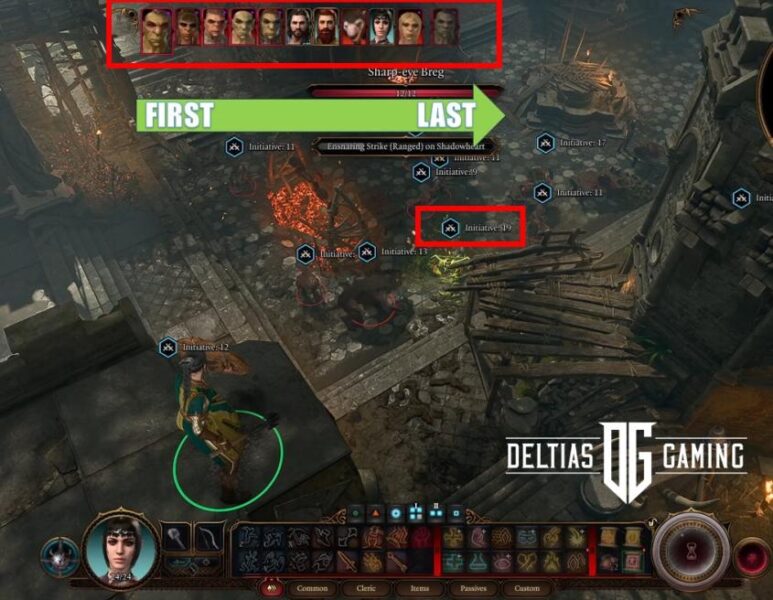
The initiative mechanic in Baldur’s Gate 3 determines the order in which characters and creatures take their turns during combat. It is determined by rolling a d20 and adding your Dexterity modifier. The character or creature with the highest initiative goes first, followed by the character or creature with the second-highest initiative, and so on.
Initiative affects the order in which characters and creatures take their turns during combat. This is important because it can give you a significant advantage if you go first. For example, you can attack an enemy before they have a chance to attack you, or you can cast a spell that will give you an edge in the fight.
There’s an extra component of an initiative called Surprise which is a status effect. Surprise is usually triggered when one or more characters (typically the aggressors) can take the other group by surprise due to stealth, cunning, or a sudden attack. This catches the enemy off guard, and they cannot take use actions, bonus actions, or reactions for a turn.
The goal is to have at least one character with a high dexterity score in your group. You want to approach each known fight in stealth if possible, and initiate combat from stealth. This gives you a chance of producing the Surprised status effect and gaining a massive advantage on your first couple of turns.
Action Points



In Baldur’s Gate 3, characters can access various actions that can be used in exploration and combat. These actions depend on the character’s class and equipment. There are two main types of actions: actions and Bonus Actions.
Actions are the most common type and can be performed once per turn. Some actions, like Attack, require spending Movement, while others, like Casting a Spell, do not.
Bonus Actions are special actions that can be performed in addition to the regular Action. Some Bonus Actions are granted by the character’s class , such as Cunning Action, while others, like Dash, come from certain Spells or Abilities.
The most common actions are Attack and Spell casting. Attacking only consumes your action resource, while spell casting consumes a spell slot. Cantrips, which are spells that do not consume spell slots are weaker versions of spells. You can also use consumables like Smokepowered Bomb and throw this for damage. Consider your action primarily meant for damage, but not all the time.
Actions can also be used for defensive means like Dash, or Disengage. Dash will double your movement, but consume your action. This is a good opening move if you cannot close the distance or need to reach the high ground for advantage. Disengaging allows you to avoid an Attack of Opportunity. If you are engaged and try to run away without Disengage, you will provoke a free attack from the enemy. This is shown with a red arrow or sword pointing at your character before you move.
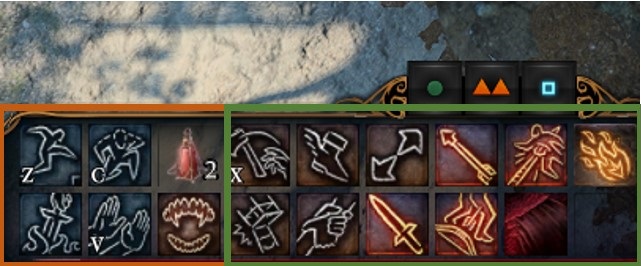
Various classes and subclasses in the game offer unique actions and bonus actions. For example, the Rogue class has Cunning Dash, which uses a bonus action for dashing, leaving the main action available for attacking. The Thief Subclass grants the Rogue two bonus actions, further enhancing their mobility and combat capabilities.
The most useful bonus action are hide, shove, and jump. Hide allows you to avoid detection, and even if you’re spotted, you can do a sneak check and still remain concealed. This is critical for Rogue who rely on “advantage” in order to get more damage via sneak attack. Shove is also useful to knock off enemies from ledges and cliffs giving an instant kill. Keep in mind, the shove is based on the strength and weight of the enemy. And lastly, we have Jump, which is normally used outside of combat in exploration. Jump is also useful to leap over allies or enemies who are blocking entrances or choke points. This is especially helpful when playing melee builds, try using jump if the movement of the game won’t let you around.
To excel in BG3 combat, it is crucial to make the most of every opportunity during battles. Unspent actions and bonus actions represent missed chances to gain an advantage or overcome difficult encounters. Remember that you cannot save or carry over actions or bonus actions to the next turn in the game’s system. So, be sure to exhaust and utilize them wisely during each turn.
Movement

Movement is the ability to move around the battlefield during your turn. It is one of the most important aspects of combat, as it allows you to position yourself for better attacks, reach enemies that are out of range, or escape from danger. Your Movement speed is determined by your race, class, and equipment. You can find your Movement speed on your character sheet.
To move your character, simply click on the ground where you want them to go. Your character will automatically path find and follow the designated route. You can also use the keyboard arrow keys to move your character. The default keys are usually “W” for forward, “A” for left, “S” for backward, and “D” for right. When not in combat or interacting with specific objects, you can freely explore the game world by moving your character around. Use the mouse to rotate the camera to get a better view of your surroundings. Scroll the mouse wheel to zoom in and out.
In combat during your turn, your movement bar can be shown in the bottom right of your screen. You can see a darkish blue circle which shows you the amount of movement you would have remained. The grey area is the amount of movement you would spend depending on how much you took. This allows you to freely move your mouse and check what movement would cost without clicking to move during turn-based combat. If you move through a square that is occupied by an enemy, you will provoke an Opportunity Attack from that enemy. An Opportunity Attack is a free attack that the enemy gets to make against you. You can avoid provoking an Opportunity Attack by using the Disengage action. The Disengage action allows you to move away from an enemy without provoking an Opportunity Attack.
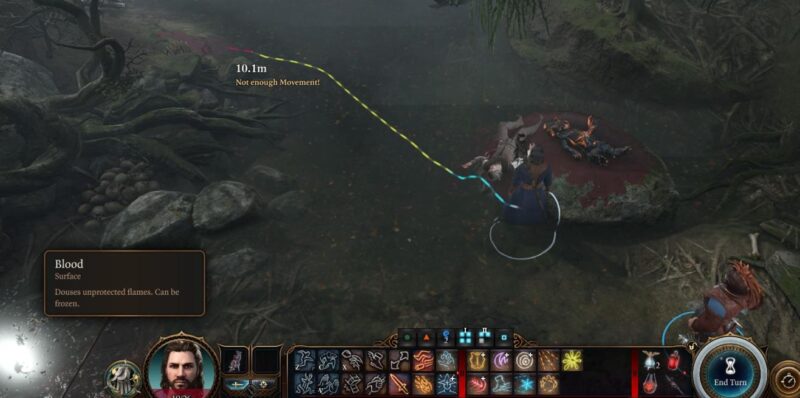
Different terrain types may have varying movement costs. For example, moving through difficult terrain like water or rough ground may reduce your movement distance. The color of your white arrow will turn a different color, yellow. This is a visual indicator you want to avoid bad terrain and moving around is usually the best option. Some areas may require you to jump over gaps or obstacles. To jump, click on the destination across the gap, and your character will attempt to jump if it’s within their movement range.
Here are some tips for using Movement effectively in Baldur’s Gate 3:
- Flanking: look for the advantage to take the opponent’s flank or rear to avoid getting hit and giving you an advantage.
- Range: Use your Movement to reach enemies that are out of range.
- Disengage: If you need to move past an enemy, you can use the Disengage action to avoid provoking an Opportunity Attack.
- Line of Sight: Get behind a rock, a tree, or a structure after attacking to avoid damage.
- Terrain: Try to avoid rough terrain and move around if you can avoid it.
- Boost Speed: use the Potion of Speed to increase your movement for three turns.
Remember, mastering movement mechanics in Baldur’s Gate 3 is essential for successful exploration and tactical combat. Practice strategic positioning, use terrain to your advantage, and be mindful of your character’s movement points during turn-based combat to gain the upper hand in battles.
Attacking
Attacking is a fundamental aspect of combat in Baldur’s Gate 3. Mastering the art of attacking will greatly increase your chances of survival and success in battles.
Here’s how attacking works in Baldur’s Gate 3:
- Attack rolls: is a d20 roll that is compared to the target’s Armor Class (AC) and if the attack roll is equal to or higher than the target’s AC, then the attack hits.
- Advantage & disadvantage: you roll the d20 twice and take the higher of the two results or the lower for the disadvantage.
- Proficiency bonus: this is a modifier that is added to your attack rolls, saving throws, and skills checks based on level and class.
- Weapon proficiency: You must be proficient with a weapon in order to use it effectively and if not will suffer a penalty or be unable to use spells.
- Damage: When you hit an enemy with an attack, you will deal damage to them, and the amount is calculated by the weapon your ability modifier, and any special conditions like fire damage.
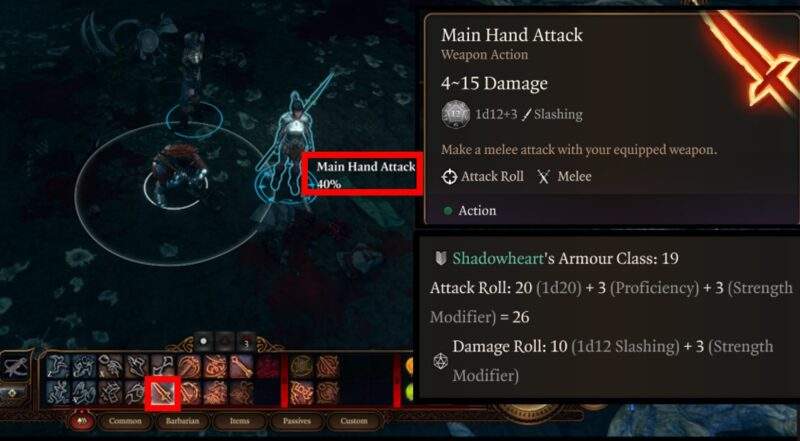
Looking at the example above, my Barbarian uses an action to attack with a “main hand attack” weapon action. There’s a 40% chance of hitting based on the above calculations which are determined in the background combat log as you attack. The attack landed with my Attack Roll then Damage Roll to determine how hard it would hit. You can open your combat log on the right side of your User Interface and highlight these actions to learn. This is the basics of attacking in Baldur’s Gate 3.
Spellcasting
Spellcasting in Baldur’s Gate 3 is a bit more complex than weapon attacks. You have spell slots which are limited use spells until you long rest at camp. Once you expend your spell slots, you simply cannot cast the spells. Cantrips are weaker versions of spells that require spell slots and can be cast indefinitely typically using an action. You have different levels of spells as well, 1-5 with level 5 the highest tier being accessible at character level 12. If it that weren’t complex enough, individual classes have magic-based mechanics unique to them, like Sorcererer and Metamagic.
However, the general premise of attacking when using an offensive spell remains the same. Attack Roll, damage roll and you land and do damage based on the strength of the spell. You can also crowd control enemies meaning preventing them from moving, taking a turn, or dropping their weapon, and so on. Like damage spells, you make a dice roll and the enemy makes a saving throw. These background mechanics are always taking place to determine if you connect and if so, how much damage is being done or what type of effect. Here’s a list of some of our favorite spells and cantrips.
Party and Companions
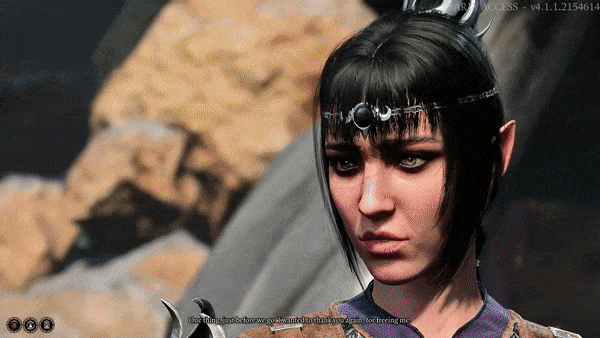
In Baldur’s Gate 3, companions are non-player characters (NPCs) that join your party and accompany you on your adventures. These companions can become valuable allies, adding depth to the game’s narrative and providing unique skills and abilities to aid you in combat and exploration. As you progress through the game, you will encounter various companions, each with their own personalities, backstories, and reasons for joining your cause.
Companions will have default classes and subclasses, but you’ll be able to respec or re-roll these companions to your liking. We recommend sticking with their origin base class because of the story synergy. You will also be able to hire mercenaries and hirelings to aid you in combat. Your party can have up to four members, including yourself. Multiplayer you can also have up to four players and fill in the remaining party members with companions, hirelings, or mercenaries.
While we have guides for companions and suggestions on their usage found here, for the sake of this guide, group composition is critical for combat. Group composition simply means, having individual members of your party serve a specific function. Instead of having a team full of melee combatants with zero range, or having a spellcasting squad of very “squishy” party members, you need a diverse set of roles and members of your party.
Here’s our recommendation for a solid party composition in Baldur’s Gate 3:
- Tank: Consider having a companion with high health and defensive abilities, like a Fighter or Paladin, to draw enemy attention and protect squishier party members.
- Support: Having a companion with healing spells, such as a Cleric or Druids, ensures your party stays healthy during battles and between encounters.
- Area Damage Dealers: Include companions with massive wide area damage like Gale who’s a Wizard so you can target and kill multiple enemies at once.
- Stealth: using a stealth, high Dexterity companion like Astarion is critical for ambushing enemies and surprising them on your initial turn.
A strong composition for the average player is as follows: Fighter, Wizard, Rogue, and Cleric. Lae’zal, Gale, Astarion, and Shadowheart fulfill these roles for you. As the main character, you can play whatever build, class, subclass, etc., but try to fill in the missing link with the above roles for a better combat experience.
Environmental Effects
In Baldur’s Gate 3, environmental effects play a significant role in shaping the battlefield and influencing combat encounters. The game features a dynamic and interactive environment, where various elements can affect both the player characters and the enemies. These environmental effects add an extra layer of strategy and challenge to the gameplay.

Different types of terrain can impact movement and combat. Traversing through the spell grease puts a liquid on the ground causing you to slip and fall to a prone position losing a turn. This is a great spell to combine with fire for an environmental combination. Characters caught in this area take fire damage over time.
The environmental effects extend to acid, water, and electricity combined and fog to obscure the line of sight. You can also use the shove command to knock someone off a cliff and completely overpower a much stronger enemy if you have the strength to do so. These environmental effects work in the reverse direction as well, as casting “Water” on a burning surface will create steam, blocking vision and removing the flames.
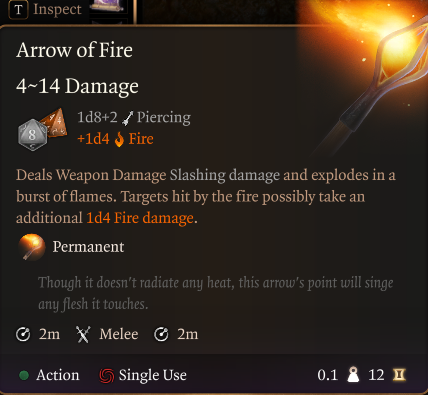
It’s a good idea to keep a variety of elemental types of arrows with you on your travels. You can use these to produce specific environmental interactions without having to cast spells simply using consumable one-time-use arrows. You can also examine enemies as well and see which type of resistances, immunities, and vulnerabilities they have to elemental effects.
Healing

Healing is a vital aspect of survival in Baldur’s Gate 3, as battles can be challenging, and injuries can accumulate quickly. Properly managing healing resources and knowing when and how to heal can greatly impact your success in the game. You can heal your character during combat by using healing potions, spells, or abilities as well as outside of combat.
Here is a list of how to heal in Baldur’s Gate 3:
- Potions: consumable one-time-use potions can heal a set amount of health.
- Spells: Clerics, druids, and paladins have healing spells that restore health.
- Resting: using short rest while exploring twice, or long rest returning to camp and consuming resources.
- Bard Song of Rest: essentially a Bard spell providing a short rest for your group.
When it comes to healing in BG3, it’s quite simple. A lot of the time, post-fights require you to spend short rest, potions, or both to heal too full. You then rely on long rest to refill your health and spell slots. During combat, having each member equipped with health potions is helpful considering not every class can self-heal. Another idea is to store in each character an invisibility potion in case they get in trouble. Lastly, keeping spell scrolls with powerful healing is another good option.
Death
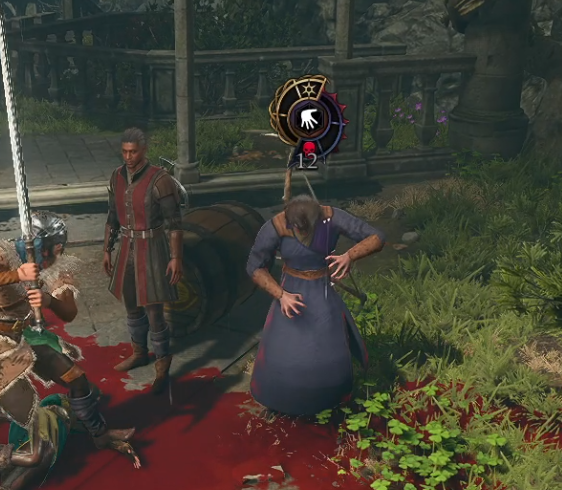


Death in Baldur’s Gate 3 is a critical element of the game that adds both challenge and consequence to the player’s journey. When a character’s hit points (HP) drop to zero or below, they become incapacitated, and the game enters the death-saving throw mechanic. The fate of the character hangs in the balance, depending on the outcome of subsequent dice rolls.
Here’s an explanation of death in Baldur’s Gate 3:
- Incapacitated State: When a character’s HP reaches zero or falls below, they can no longer take any actions or participate in combat.
- Death Saving Throws: While in the incapacitated state, a character must make death saving throws at the start of their turn.
- Successes & Failures: three successes stabilize the character, preventing them from dying while three failures result in death,
- Healing and Revival: Allies can use healing spells, potions, or abilities to stabilize an incapacitated character, bringing them back to consciousness with a small amount of HP.
- Permanent Death: If a character accumulates three failures and dies, their death is permanent.
- Resurrection: Players can resurrect fallen allies with Withers the NPC recruited early in the game and found at your camp.
Death in Baldur’s Gate 3 adds a sense of risk and consequence to the game, making every decision and action significant. Players must think tactically, support their party members, and be prepared to face the challenges that come their way. Properly handling death and understanding its mechanics is essential to ensuring the survival of your characters and successfully navigating the treacherous world of Baldur’s Gate 3.
Looking for More Baldur’s Gate 3?
Thank you for reading Baldur’s Gate 3: Combat Explained guide. We provide the latest news and create guides for Baldur’s Gate 3. Also, watch me play games on Twitch or visit my YouTube channel!
 Reddit
Reddit
 Email
Email


